Sun Bears
Small in size but big in personality
The sun bear (Helarctos malayanus) is the smallest bear species in the world and one of the least studied. They inhabit the tropical forests of South East Asia, ranging from the eastern tip of India, Bangladesh, through Burma, Laos, Thailand, Cambodia, Vietnam, Malaysia and the islands of Sumatra and Borneo.
Throughout their range, sun bears are being threatened by large-scale habitat destruction, forest fires, poaching for their gall bladders and other body parts and illegal pet trade. The primary threat to wild sun bear populations in Indonesia is habitat loss. This in turn gives rise to conflict between humans and bears as bears pushed out of their natural habitat and occasionally enter gardens and feed on crops.
Sun bears have been protected in Indonesia since 1973. It is illegal to trade in or posses sun bears and their parts. Despite fairly good legal protection on paper, law enforcement in Indonesia is weak at its best. This also applies to many other rare and endangered species such as orangutans, proboscis monkeys, and clouded leopards. The Bornean lowland dipterocarp forests are extremely rich in biodiversity. Sadly, these forests are rapidly being destroyed by the over-harvesting of trees, conversion to oil palm plantations, and forest fires. Landslides, erosion, local droughts and flooding, are increasing in frequency due to this over-exploitation and destruction.
In 1997, Gabriella Fredriksson began the first long term research on sun bears in the Sungai Wain Protection Forest . This forest, located with Balikpapan’s boundaries, is home to an estimated 50-100 wild sun bears. Gabriella’s research and conservation efforts generated publicity and focused attention on the sun bear, eventually leading to it becoming the districts Mascot in 2002.
PDF Papers
Gallery
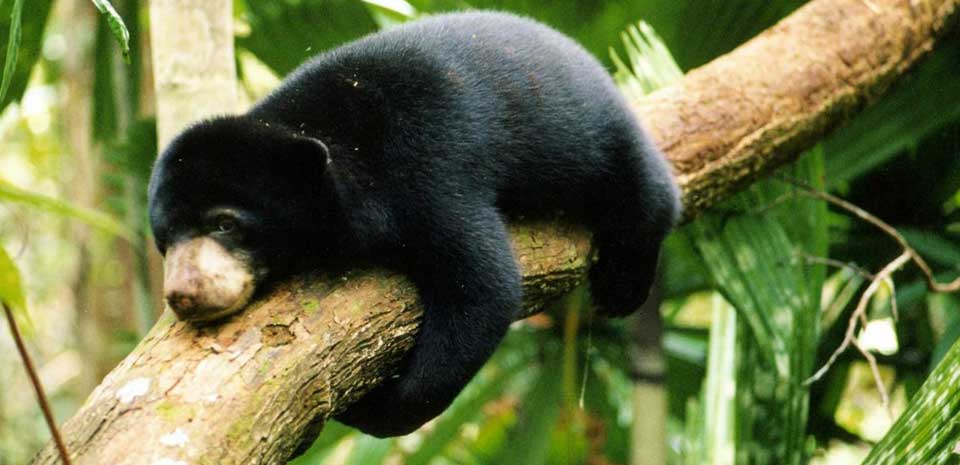
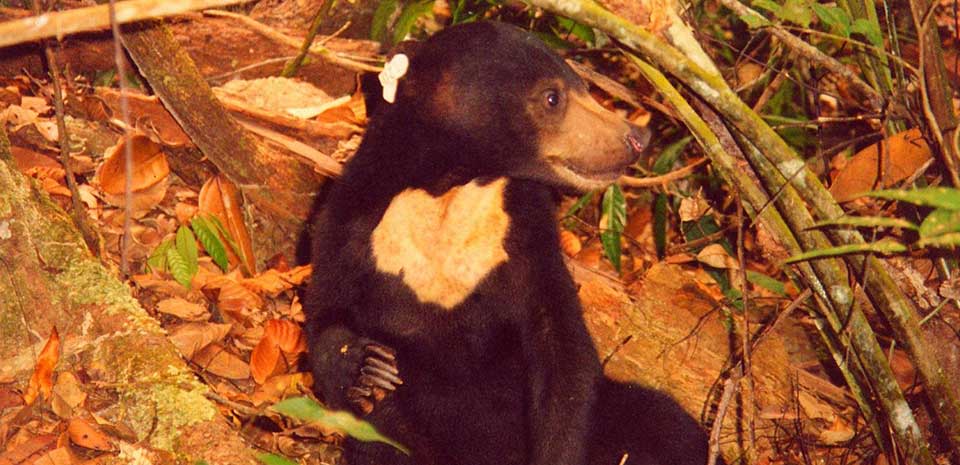
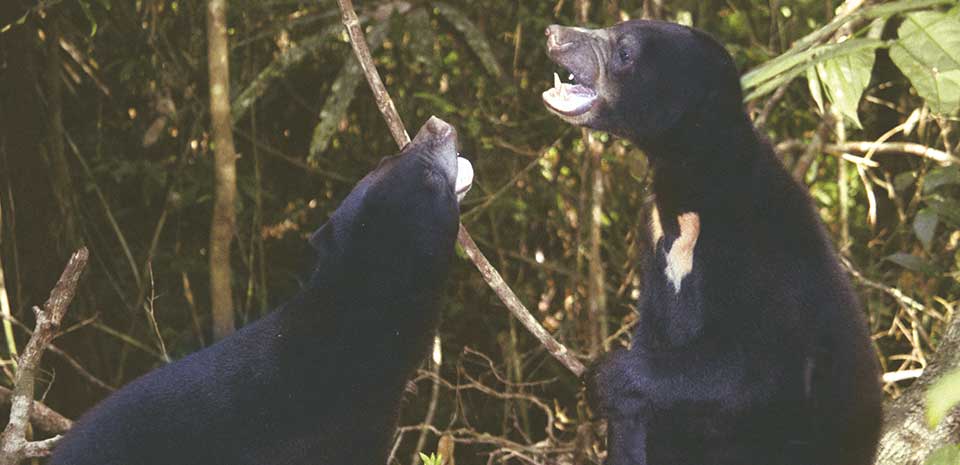

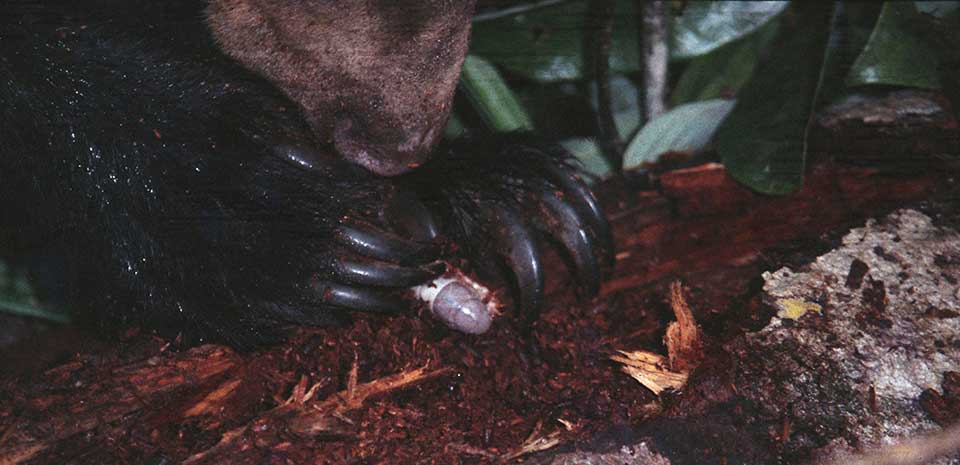
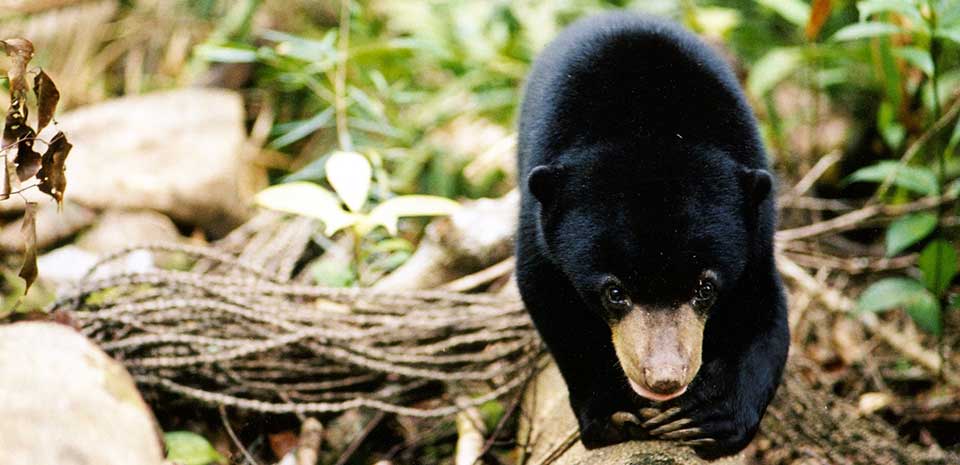
Sun Bear Facts
Physical Characteristics
The smallest of the world’s eight living bear species. Bornean sun bears seem to be the smallest and possibly subspecies status is warranted (H. malayanus eurispylus). On Borneo the sun bear weighs only about 35 to 65 kilograms (75 to 145 pounds), but bears in Sumatra and on mainland Southeast Asia weigh between 50-80 kg, although little data from the wild is available. Its short sleek fur is usually black, but can occasionally range from reddish brown to gray. Almost every sun bear has an individually distinct chest patch that is typically yellow, orange, or white, but may sometimes be speckled or spotted. The sun bear has a broad muzzle that is relatively short, and a large head that gives the bear a dog-like appearance. It has small rounded ears, a fleshy forehead that sometimes looks wrinkled, and an extremely long tongue (longest of all bear species). With feet turned slightly inward, large naked paws, and long curved claws, the sun bear is well adapted for climbing trees. It’s feet are extraordinarily large compared to it’s body size, potentially assisting in digging and breaking into dead wood in search for insects.
Distribution
The range of this species is not well documented, either historically or presently. However, the sun bear has been seen throughout Southeast Asia from the eastern edge of India, northern Burma to Laos, Cambodia, Vietnam, and Thailand, and farther south to peninsular Malaysia and on the islands of Sumatra and Borneo. There are historical records indicating that the sun bear was once present in eastern Tibet, Bangladesh, and portions of India and China and the island of Java. However, due to large scale habitat destruction and poaching, the sun bear’s range has been substantially reduced from its historic extent. The sun bear is believed to be extinct in Tibet and Bangladesh; it is likely that only very small numbers remain in southern China, if the sun bear is not actually extinct there as well.
Habitat
Tropical hardwood rainforests are the sun bear’s main habitat. These forests are highly valued by humans for timber production, and are being rapidly converted to second growth forest, cash-crop plantation agriculture and subsistence farming, grazing areas, and human settlements. Malaysia and Indonesia are the world’s leading exporters of tropical hardwoods, and most of these exports originate from the sun bear’s shrinking habitat. The specific impacts on sun bear distribution, population numbers and density, and food supply are unknown; but the consequences are certainly detrimental. These human activities replace important native lowland tropical forest with large expanses of land that cannot be used by bears. Necessary sun bear habitat is eliminated; and the plants, insects, and other foods the bears need also disappear. Deprived of their natural food resources, sun bears sometimes feed on cultivated crops – particularly palm hearts – and thereby destroy them. Such depredating bears are persecuted by landowners and are often killed.
Diet & Feeding Behavior
Sun bears are omnivores, and primarily feed on termites, ants and beetle larvae, bee larvae and honey, and a large variety of fruits, when available. Occasionally certain flowers are eaten. Vegetation, like grasses or leaves, hardly feature in the diet. Near the forest edge in gardens they occasionally feed on the growing tips of palm trees, and occasionally small mammals and bird eggs. Their long sharp claws enable them to dig easily into the ground, break into logs, and their massive jaw muscles make it possible to bite through the bark of trees in search of insects and honey, and their long tongues help them to extract these foods from crevices.
Social System
Almost nothing is known about the behavior or social structure of wild sun bears. Limited anecdotal accounts, coupled with inferences drawn from the animal’s physical characteristics, provide virtually the only available information. The sun bear is believed to be a mostly solitary animal, like other bears. Most frequently encountered social groups are females with their cubs. Reports exist of several bears aggregating near favorite fruit trees when fruiting is exceptional. The sun bear has been found to spend most of it’s daytime hours foraging for insects and fruits, both on the forest floor as well as in trees, and resting during the warmest midday hours and at night. The sun bear does not undergo winter sleep (hibernation), because its varied food sources are typically available year-round in its tropical habitat.
Reproduction
Little knowledge is available regarding sun bear reproduction and cub rearing in the wild. Usually females are seen with only one cub at a time, and only rarely are twins seen. Female sun bears also only have 4 active nipples, as opposed to many other bear species with larger litters that have 6 active nipples for nursing cubs. It seems that sun bears are a-seasonal breeders, possibly linked to irregular fruiting cycles and large local variation in food supplies. It is possible that sun bears like other bears, may have delayed implantation to ensure cubs are born when the mother has sufficient fat reserves, the weather is favorable, and seasonally important foods are available. However, this is not known. Sun bears give birth in dens or hollow trees where the cub remains protected for some period of time until it is able to venture out to accompany the mother while she forages and travels.
Conservation Status
The World Conservation Union (IUCN) has recently (October 2007) reclassified the sun bear from ‘Data Deficient’ to ‘Vulnerable’. This designation means that sun bears are currently vulnerable to extinction, primarily based on the fact that their habitat has been, and still is, shrinking. Factors causing a continuing decline in this species include: fragmentation and destruction of the sun bear’s tropical hardwood forest habitat due to human encroachment; large scale forest fires that severely damage the rainforest habitat; hunting of these bears to serve the trade in bear parts for use in traditional medicines; capture of sun bears as pets; and the killing of bears due to increasing human-bear conflicts. Habitat loss and excessive human-caused mortality have already led to the extinction of many sun bear populations. Only recently some field studies have started investigating basic biology, ecology, and behavior of wild sun bears. Conservation of sun bears needs to focus on protection of their forest habitat, proper management of these areas, strict enforcement of their legal status (which in most countries of their range is that they are a protected species, even outside protected areas), minimizing human-bear conflict near forest areas, and halting trade in bear parts.
